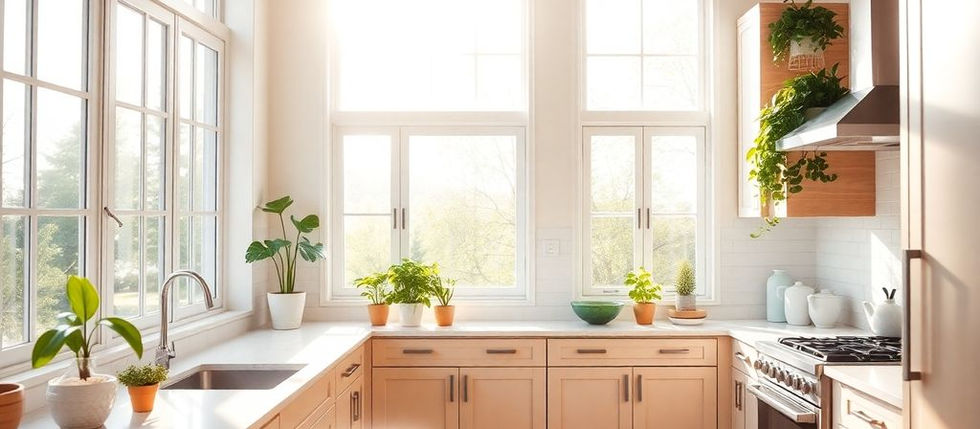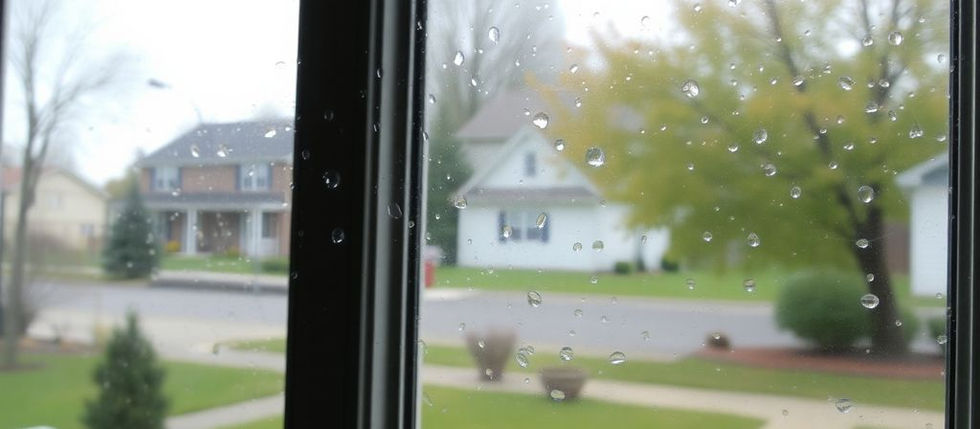Living in Norwalk, keeping your home comfortable and energy-efficient is a big deal. And guess what? Attic ventilation plays a huge role in that. It helps keep your roof in good shape, cuts down on energy costs, and even makes the air inside your house better to breathe. If you haven't thought about your attic ventilation lately, it's probably time to start.
Key Takeaways
Attic ventilation is key for keeping energy costs down by letting hot air escape in the summer.
Proper ventilation protects your roof from damage caused by heat and moisture buildup.
Good airflow in the attic helps improve indoor air quality by reducing dust and allergens.
Regular checks and maintenance of attic vents can prevent costly repairs in the future.
Investing in attic ventilation can increase your home's value by extending the life of your roof and insulation.
Understanding the Basics of Attic Ventilation
What is Attic Ventilation?
Attic ventilation is all about managing the airflow in your attic space. It involves allowing fresh air to enter and stale, hot, or moist air to exit. This process helps in maintaining a balanced temperature and humidity level in your attic, which is crucial for the overall health of your home. Proper attic ventilation can prevent a host of problems from structural damage to higher energy bills.
How Attic Ventilation Works
The mechanics of attic ventilation are pretty straightforward. It typically involves a system of intake and exhaust vents. Intake vents are usually located at the lower part of the roof, such as the eaves or soffits, and their job is to let cool air in. Exhaust vents are placed higher up, like on the roof ridge, allowing warm, humid air to escape. This continuous exchange of air helps regulate the attic temperature and moisture levels.
Common Types of Attic Vents
There are several types of attic vents you might consider:
Ridge Vents: Installed at the peak of the roof, these vents provide a continuous air outlet and are often combined with soffit vents for intake.
Soffit Vents: Located under the eaves, these are crucial for allowing air to enter the attic space.
Gable Vents: Positioned on the gable ends of the house, they allow air to flow through the attic.
Each type of vent plays a specific role in ensuring effective ventilation, and the right combination depends on your specific home design and climate needs. In places with unpredictable weather, like Hartford, proper attic ventilation can also help in managing energy efficiency and protecting your home’s structure.
Benefits of Proper Attic Ventilation for Norwalk Homes
Energy Efficiency and Cost Savings
When it comes to keeping your home comfy and your wallet happy, attic ventilation is a game-changer. Proper ventilation helps hot air escape in summer, so your air conditioner doesn't have to work overtime. This means you save on energy bills. Plus, in winter, it stops moisture from hanging around, which can mess with your insulation. Here's a quick list of benefits:
Lowers energy consumption
Reduces wear and tear on HVAC systems
Cuts down on cooling and heating costs
Protecting Roof and Insulation
Your roof and insulation are like the unsung heroes of your home. They need protection, and that's where good ventilation steps in. By letting air flow freely, you avoid problems like ice dams in winter and heat buildup in summer. This keeps your roof in top shape and extends the life of your insulation. A well-ventilated attic means:
No more ice dams causing leaks
Less risk of mold and mildew
Longer-lasting roofing materials
Enhancing Indoor Air Quality
Indoor air quality is something we often overlook, but it's super important. With proper attic ventilation, stale air and pollutants don't get trapped inside. This is a big deal for anyone with allergies or respiratory issues. A ventilated attic helps by:
Reducing allergens and pollutants
Improving overall air freshness
Creating a healthier living environment
In Norwalk, where the weather can get pretty extreme, having a well-ventilated attic isn't just a luxury—it's a necessity. It keeps your home comfortable year-round and saves you from unexpected repair costs. If you've noticed window condensation or other signs of poor air circulation, it might be time to consider professional repair or replacement.
Identifying Signs of Poor Attic Ventilation
Common Indicators of Ventilation Issues
Recognizing the signs of poor attic ventilation can save you from future headaches. A clear sign is when your attic feels like a sauna in the summer or an icebox in the winter. This extreme temperature fluctuation suggests that hot air isn't escaping in the summer, and cold air isn't being properly vented in the winter.
Here are a few more telltale signs:
Ice Dams: In winter, if snow melts unevenly on your roof, it might refreeze at the eaves, forming ice dams.
Mold and Mildew: Notice a musty smell or see black spots on the ceiling? That's a red flag for mold, often due to trapped moisture.
Peeling Paint: If your home's paint is peeling or blistering, especially in the attic or upper floors, it might be due to excess moisture.
Impact of Poor Ventilation on Home Structure
Poor ventilation isn't just uncomfortable—it can actually damage your home. Moisture buildup can lead to wood rot, affecting the structural integrity of your roof and walls. Attic insulation can also deteriorate, reducing its effectiveness and causing your energy bills to skyrocket.
Moreover, excessive heat can cause roofing materials to expand and contract, leading to cracks and leaks. This not only shortens the lifespan of your roof but also invites costly repairs.
When to Seek Professional Help
Sometimes, the signs aren't obvious, and that's when you might need a pro. If you're unsure about the state of your attic's ventilation, it's wise to call in an expert. They can assess whether your ventilation system is up to par or if you need improvements.
Getting a professional to evaluate your attic's ventilation can prevent minor issues from turning into major problems.
Consider scheduling regular inspections to catch issues early. And remember, improving attic ventilation not only protects your home but also keeps it comfortable year-round.
Solutions for Improving Attic Ventilation in Norwalk
Choosing the Right Ventilation System
Picking the right ventilation system for your attic can seem daunting, but it's crucial for maintaining a comfortable home. There are several options to consider:
Ridge Vents: These are installed at the peak of the roof and allow hot air to escape efficiently.
Soffit Vents: Positioned under the eaves, they let cooler air flow into the attic.
Gable Vents: Located on the gable ends, these vents are effective for cross-ventilation.
Each type has its benefits, so it's important to assess your home's specific needs before making a choice.
Installation Tips for Homeowners
If you're a DIY enthusiast, installing attic vents might be on your to-do list. Here are some tips to help:
Plan the Layout: Ensure a balanced airflow by strategically placing intake and exhaust vents.
Use the Right Tools: Having the correct tools will make the installation smoother and more efficient.
Follow Safety Guidelines: Always prioritize safety by wearing protective gear and working with a partner if possible.
Remember, while DIY can be rewarding, don't hesitate to call in a professional if things get tricky.
Professional Ventilation Services
Sometimes, it's best to leave it to the experts. Professional services not only ensure proper installation but also provide peace of mind. Companies like Connecticut Custom Creations™ offer tailored solutions, including custom storage and energy-efficient options, making your attic a functional space.
Investing in professional services might seem costly upfront, but it can save you money in the long run by preventing potential damage and improving energy efficiency.
Seasonal Considerations for Attic Ventilation
Preparing for Norwalk Winters
Winter in Norwalk can be pretty harsh, and your attic needs to be ready. Proper ventilation helps maintain a consistent roof temperature, which is key to preventing ice dams. These pesky ice formations can cause water to seep under shingles, leading to roof damage. Keeping your attic well-ventilated ensures the roof's longevity and shields your home from potential water damage. Here are a few steps to prepare:
Inspect insulation: Make sure it's not blocking vents.
Check for leaks: Seal any gaps to prevent warm air from escaping.
Ensure proper airflow: Consider adding more vents if necessary.
Summer Ventilation Strategies
When summer hits Norwalk, the attic can turn into a sauna. Without good ventilation, the heat can seep into your home, making it uncomfortable and driving up energy bills. To keep things cool:
Install exhaust vents: These help release hot air.
Use attic fans: They boost the airflow and help in cooling down the space.
Consider an attic inspection: This ensures everything is working as it should.
Year-Round Maintenance Tips
Regular maintenance is crucial for keeping your attic in top shape. By doing a few simple checks, you can avoid costly repairs and ensure your attic's ventilation is working properly:
Clean vents: Remove debris to ensure nothing is blocking airflow.
Inspect regularly: Look for signs of mold or moisture.
Schedule professional inspections: A pro can spot issues you might miss.
Keeping your attic well-ventilated throughout the year not only saves energy but also prolongs the life of your roof and insulation. It's a small effort for a big payoff.
Health and Safety Implications of Attic Ventilation
Preventing Mold and Mildew
Proper attic ventilation is like a secret weapon against mold and mildew. When moisture sneaks into your attic, it can create the perfect breeding ground for these pesky problems. Good ventilation ensures that dampness doesn't stick around, helping to keep your home healthier. Without it, you might find yourself dealing with mold-related health issues, especially if someone in your house has allergies or asthma.
Reducing Allergens and Pollutants
Attic ventilation plays a crucial role in maintaining indoor air quality. By allowing fresh air to circulate, it helps to reduce allergens and pollutants that might otherwise linger in your home. This is particularly important in areas prone to high humidity, where poor ventilation can lead to increased dust mites and other allergens. A well-ventilated attic means a fresher, healthier living space.
Ensuring a Safe Living Environment
A safe home is a happy home, and proper attic ventilation is a big part of that. It helps to regulate temperatures, preventing the buildup of heat that can damage roofing materials and lead to structural issues. Plus, by keeping moisture at bay, you reduce the risk of wood rot and other problems that can compromise your home's safety. With effective attic ventilation, you're not just protecting your roof—you're safeguarding your entire living environment.
Investing in upgrading attic ventilation is essential for creating a safe, comfortable, and healthy home environment. It’s not just about keeping cool in the summer; it’s about ensuring your family’s well-being all year round.
Financial Advantages of Investing in Attic Ventilation
Lowering Energy Bills
Investing in attic ventilation can lead to noticeable savings on your energy bills. When your attic is properly ventilated, it allows hot air to escape, which means your cooling system doesn't have to work overtime during the summer. This results in lower energy consumption and reduced costs. Homeowners in Norwalk can particularly benefit from this, as it can make a significant difference in their monthly utility expenses.
Avoiding Costly Repairs
Proper attic ventilation helps prevent issues like mold growth and roof damage, which can be expensive to fix. By maintaining a well-ventilated attic, you can sidestep major repair costs. Here are some common repairs you might avoid:
Roof replacement
Mold remediation
Insulation replacement
Regular maintenance and inspections are key to avoiding these costly problems.
Increasing Property Value
Homes with effective attic ventilation systems often have a higher market value. Potential buyers are more likely to invest in a property that promises lower energy costs and fewer maintenance issues. This makes attic ventilation not just a practical improvement but a financially savvy one as well.
Investing in attic ventilation is a smart financial decision that not only reduces your current expenses but also boosts your home's overall value. By ensuring your attic is well-ventilated, you're making a long-term investment in your property's future.
Investing in attic ventilation can save you money in the long run. Proper ventilation helps keep your home comfortable and can lower energy bills. If you're curious about how to improve your attic's airflow and save cash, visit our website for more information!
Wrapping It Up: Why Attic Ventilation Matters
So, let's wrap this up. If you're living in Norwalk, keeping your attic well-ventilated is more than just a good idea—it's a must. It keeps your home comfy by letting hot air out in the summer and stopping moisture from building up in the winter. This means your roof and insulation last longer, and you save on energy bills. Plus, it helps prevent those pesky ice dams and mold problems. If you haven't checked your attic's ventilation lately, now's the time. A little attention now can save you a lot of hassle and money down the road. So, go ahead, take a peek up there and make sure everything's in good shape. Your home will thank you!
Frequently Asked Questions
Why is attic ventilation important for my home?
Attic ventilation helps your home stay comfy by getting rid of hot air in the summer and stopping moisture in the winter. This keeps your roof and insulation safe.
How does proper ventilation lower energy bills?
Good ventilation lets hot air escape in the summer, so you don't need as much air conditioning. This can really cut down your energy costs.
What are ice dams and how can ventilation stop them?
Ice dams happen when snow melts on the roof and refreezes at the edges. Proper ventilation keeps the roof's temperature even, stopping this problem.
What types of attic vents are there?
There are different kinds like ridge vents, soffit vents, and gable vents. They all help air move in and out of the attic.
How often should I check my attic ventilation?
It's good to check your attic ventilation regularly to make sure it's working right and not blocked by anything.
Can attic ventilation improve indoor air quality?
Yes, proper ventilation helps keep the air in your home fresh by reducing dust and allergens, which is great for people with allergies.















Comments